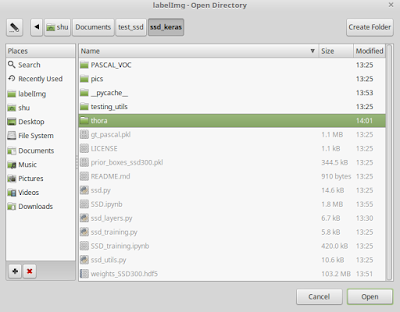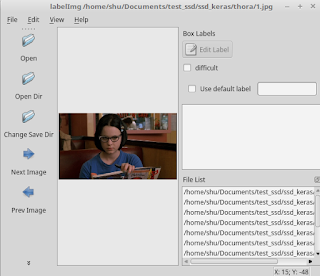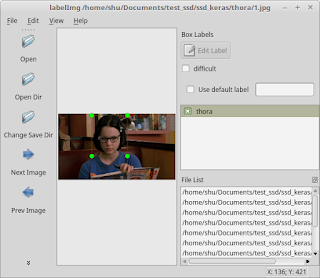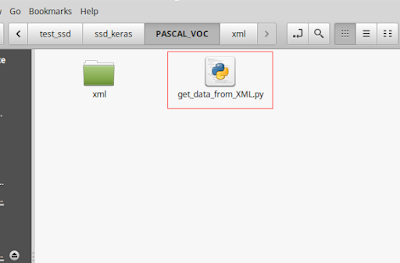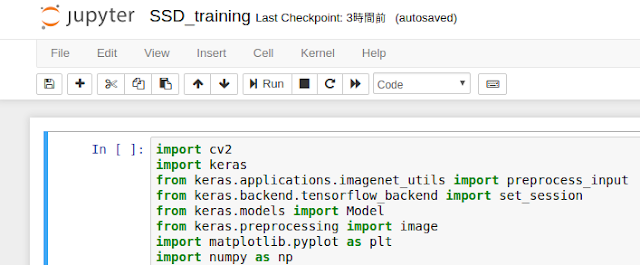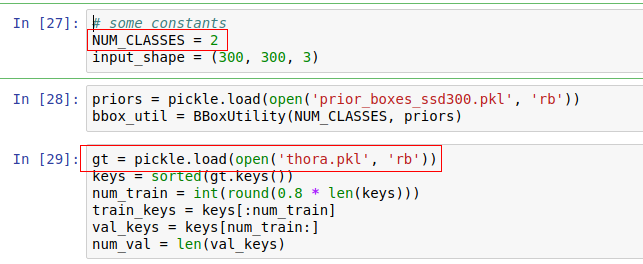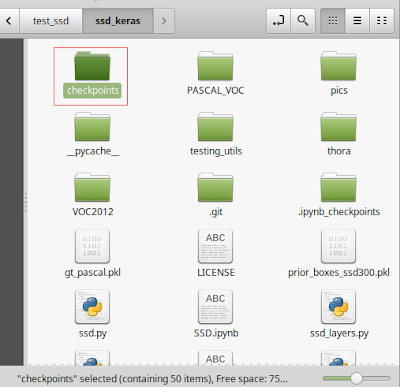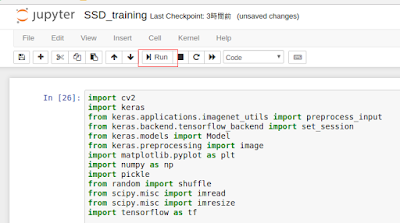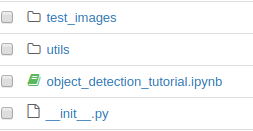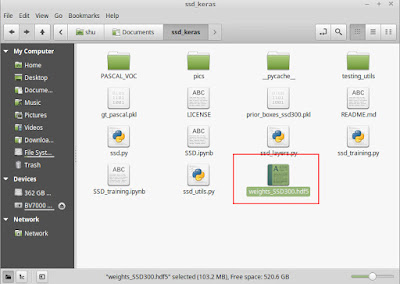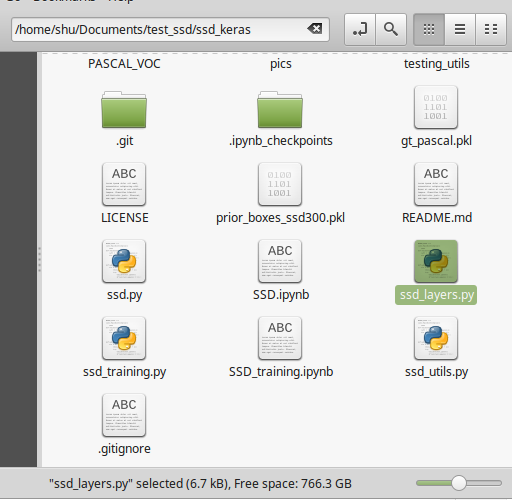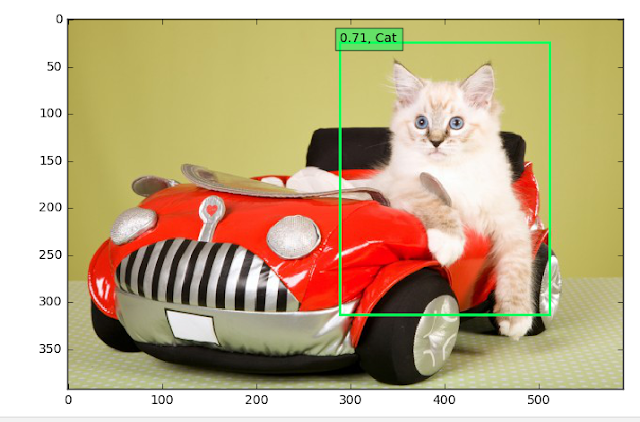We have installed and tested if the SSD works in the last post. Now we will train a model for ssd_keras.
At first we need an dataset. I downloaded 120 pics (.jpg) of Thora Birch of Ghost World.
I made a folder like this:
And pictures are in the folder:
From these pictures, we will make a dataset.
$ git clone https://github.com/tzutalin/labelImg.git
$ cd labelImg
$ python3.5 labelImg.py
labelImg will open. Select "Open Dir".
Choose the thora folder.
Opened.
From the top of window, "Edit" -> "Create Rectbox". And create a rectangle box on her face. The category name is "thora".
Create rectbox on other 119 pictures of her also.
Finished.
Move all of xml file of thora we created into the xml folder.
We need to change get_data_from_XML.py a bit. Use this code:
import numpy as np
import os
from xml.etree import ElementTree
class XML_preprocessor(object):
def __init__(self, data_path):
self.path_prefix = data_path
self.num_classes = 1 ##changed num of the classes
self.data = dict()
self._preprocess_XML()
def _preprocess_XML(self):
filenames = os.listdir(self.path_prefix)
for filename in filenames:
tree = ElementTree.parse(self.path_prefix + filename)
root = tree.getroot()
bounding_boxes = []
one_hot_classes = []
size_tree = root.find('size')
width = float(size_tree.find('width').text)
height = float(size_tree.find('height').text)
for object_tree in root.findall('object'):
for bounding_box in object_tree.iter('bndbox'):
xmin = float(bounding_box.find('xmin').text)/width
ymin = float(bounding_box.find('ymin').text)/height
xmax = float(bounding_box.find('xmax').text)/width
ymax = float(bounding_box.find('ymax').text)/height
bounding_box = [xmin,ymin,xmax,ymax]
bounding_boxes.append(bounding_box)
class_name = object_tree.find('name').text
one_hot_class = self._to_one_hot(class_name)
one_hot_classes.append(one_hot_class)
image_name = root.find('filename').text
bounding_boxes = np.asarray(bounding_boxes)
one_hot_classes = np.asarray(one_hot_classes)
image_data = np.hstack((bounding_boxes, one_hot_classes))
self.data[image_name] = image_data
## Changed to one category.
def _to_one_hot(self,name):
one_hot_vector = [0] * self.num_classes
if name == 'thora':
one_hot_vector[0] = 1
else:
print('unknown label: %s' %name)
return one_hot_vector
## example on how to use it
import pickle
data = XML_preprocessor('./xml/').data
pickle.dump(data,open('thora.pkl','wb'))
It isn't so big change. I just changed the number of categories to 1 (thora) and made it to generate thoara.pkl. Delete the original code of get_data_from_XML.py and copy and paste this code into the file.import os
from xml.etree import ElementTree
class XML_preprocessor(object):
def __init__(self, data_path):
self.path_prefix = data_path
self.num_classes = 1 ##changed num of the classes
self.data = dict()
self._preprocess_XML()
def _preprocess_XML(self):
filenames = os.listdir(self.path_prefix)
for filename in filenames:
tree = ElementTree.parse(self.path_prefix + filename)
root = tree.getroot()
bounding_boxes = []
one_hot_classes = []
size_tree = root.find('size')
width = float(size_tree.find('width').text)
height = float(size_tree.find('height').text)
for object_tree in root.findall('object'):
for bounding_box in object_tree.iter('bndbox'):
xmin = float(bounding_box.find('xmin').text)/width
ymin = float(bounding_box.find('ymin').text)/height
xmax = float(bounding_box.find('xmax').text)/width
ymax = float(bounding_box.find('ymax').text)/height
bounding_box = [xmin,ymin,xmax,ymax]
bounding_boxes.append(bounding_box)
class_name = object_tree.find('name').text
one_hot_class = self._to_one_hot(class_name)
one_hot_classes.append(one_hot_class)
image_name = root.find('filename').text
bounding_boxes = np.asarray(bounding_boxes)
one_hot_classes = np.asarray(one_hot_classes)
image_data = np.hstack((bounding_boxes, one_hot_classes))
self.data[image_name] = image_data
## Changed to one category.
def _to_one_hot(self,name):
one_hot_vector = [0] * self.num_classes
if name == 'thora':
one_hot_vector[0] = 1
else:
print('unknown label: %s' %name)
return one_hot_vector
## example on how to use it
import pickle
data = XML_preprocessor('./xml/').data
pickle.dump(data,open('thora.pkl','wb'))
And run it:
$ python3.5 python3.5 get_data_from_XML.py
You will get thora.pkl.
Move it to ssd_keras folder.
Now you are ready to use the .pkl file and its dataset. But we need to configure the pyrhon file to use the .pkl file and the dataset.
Go to the directory of SSD on console.
$ cd your/directory/to/ssd_keras
$ jupyter notebook
$ jupyter notebook
And you will see this:
Open SSD_training.ipynb.
You will see this:
Change the number of classes to "2" and the pkl file to load to "thora.pkl".
2 Classes: thora class and others class. Others class is always needed.
Also change the path_prefix and the path passed to Generator. Please note that the number 16 passed in Generator is a batch size (which means how many pictures you load at once for training). If the number of picture samples are not enough in the dataset, decrease it to smaller number. The bigger the batch size is, the better result you tend to have. But you need strong GPU if the batch size is too big.
Before running the program, make sure that you made "checkpoints" folder in ssd_keras. Learned weight will be saved in this folder (every epoch).
Run the program.
The result:
You can transform .ipynb file to .py file this way:
$ jupyter nbconvert --to python SSD_training.ipynb
My code transformed for your reference (.py):
# coding: utf-8
# In[24]:
import cv2
import keras
from keras.applications.imagenet_utils import preprocess_input
from keras.backend.tensorflow_backend import set_session
from keras.models import Model
from keras.preprocessing import image
import matplotlib.pyplot as plt
import numpy as np
import pickle
from random import shuffle
from scipy.misc import imread
from scipy.misc import imresize
import tensorflow as tf
from ssd import SSD300
from ssd_training import MultiboxLoss
from ssd_utils import BBoxUtility
#get_ipython().run_line_magic('matplotlib', 'inline')
plt.rcParams['figure.figsize'] = (8, 8)
plt.rcParams['image.interpolation'] = 'nearest'
np.set_printoptions(suppress=True)
# config = tf.ConfigProto()
# config.gpu_options.per_process_gpu_memory_fraction = 0.9
# set_session(tf.Session(config=config))
# In[25]:
# some constants
NUM_CLASSES = 2
input_shape = (300, 300, 3)
# In[26]:
priors = pickle.load(open('prior_boxes_ssd300.pkl', 'rb'))
bbox_util = BBoxUtility(NUM_CLASSES, priors)
# In[27]:
gt = pickle.load(open('thora.pkl', 'rb'))
keys = sorted(gt.keys())
num_train = int(round(0.9 * len(keys)))
train_keys = keys[:num_train]
val_keys = keys[num_train:]
num_val = len(val_keys)
# In[28]:
class Generator(object):
def __init__(self, gt, bbox_util,
batch_size, path_prefix,
train_keys, val_keys, image_size,
saturation_var=0.5,
brightness_var=0.5,
contrast_var=0.5,
lighting_std=0.5,
hflip_prob=0.5,
vflip_prob=0.5,
do_crop=True,
crop_area_range=[0.75, 1.0],
aspect_ratio_range=[3./4., 4./3.]):
self.gt = gt
self.bbox_util = bbox_util
self.batch_size = batch_size
self.path_prefix = path_prefix
self.train_keys = train_keys
self.val_keys = val_keys
self.train_batches = len(train_keys)
self.val_batches = len(val_keys)
self.image_size = image_size
self.color_jitter = []
if saturation_var:
self.saturation_var = saturation_var
self.color_jitter.append(self.saturation)
if brightness_var:
self.brightness_var = brightness_var
self.color_jitter.append(self.brightness)
if contrast_var:
self.contrast_var = contrast_var
self.color_jitter.append(self.contrast)
self.lighting_std = lighting_std
self.hflip_prob = hflip_prob
self.vflip_prob = vflip_prob
self.do_crop = do_crop
self.crop_area_range = crop_area_range
self.aspect_ratio_range = aspect_ratio_range
def grayscale(self, rgb):
return rgb.dot([0.299, 0.587, 0.114])
def saturation(self, rgb):
gs = self.grayscale(rgb)
alpha = 2 * np.random.random() * self.saturation_var
alpha += 1 - self.saturation_var
rgb = rgb * alpha + (1 - alpha) * gs[:, :, None]
return np.clip(rgb, 0, 255)
def brightness(self, rgb):
alpha = 2 * np.random.random() * self.brightness_var
alpha += 1 - self.saturation_var
rgb = rgb * alpha
return np.clip(rgb, 0, 255)
def contrast(self, rgb):
gs = self.grayscale(rgb).mean() * np.ones_like(rgb)
alpha = 2 * np.random.random() * self.contrast_var
alpha += 1 - self.contrast_var
rgb = rgb * alpha + (1 - alpha) * gs
return np.clip(rgb, 0, 255)
def lighting(self, img):
cov = np.cov(img.reshape(-1, 3) / 255.0, rowvar=False)
eigval, eigvec = np.linalg.eigh(cov)
noise = np.random.randn(3) * self.lighting_std
noise = eigvec.dot(eigval * noise) * 255
img += noise
return np.clip(img, 0, 255)
def horizontal_flip(self, img, y):
if np.random.random() < self.hflip_prob:
img = img[:, ::-1]
y[:, [0, 2]] = 1 - y[:, [2, 0]]
return img, y
def vertical_flip(self, img, y):
if np.random.random() < self.vflip_prob:
img = img[::-1]
y[:, [1, 3]] = 1 - y[:, [3, 1]]
return img, y
def random_sized_crop(self, img, targets):
img_w = img.shape[1]
img_h = img.shape[0]
img_area = img_w * img_h
random_scale = np.random.random()
random_scale *= (self.crop_area_range[1] -
self.crop_area_range[0])
random_scale += self.crop_area_range[0]
target_area = random_scale * img_area
random_ratio = np.random.random()
random_ratio *= (self.aspect_ratio_range[1] -
self.aspect_ratio_range[0])
random_ratio += self.aspect_ratio_range[0]
w = np.round(np.sqrt(target_area * random_ratio))
h = np.round(np.sqrt(target_area / random_ratio))
if np.random.random() < 0.5:
w, h = h, w
w = min(w, img_w)
w_rel = w / img_w
w = int(w)
h = min(h, img_h)
h_rel = h / img_h
h = int(h)
x = np.random.random() * (img_w - w)
x_rel = x / img_w
x = int(x)
y = np.random.random() * (img_h - h)
y_rel = y / img_h
y = int(y)
img = img[y:y+h, x:x+w]
new_targets = []
for box in targets:
cx = 0.5 * (box[0] + box[2])
cy = 0.5 * (box[1] + box[3])
if (x_rel < cx < x_rel + w_rel and
y_rel < cy < y_rel + h_rel):
xmin = (box[0] - x_rel) / w_rel
ymin = (box[1] - y_rel) / h_rel
xmax = (box[2] - x_rel) / w_rel
ymax = (box[3] - y_rel) / h_rel
xmin = max(0, xmin)
ymin = max(0, ymin)
xmax = min(1, xmax)
ymax = min(1, ymax)
box[:4] = [xmin, ymin, xmax, ymax]
new_targets.append(box)
new_targets = np.asarray(new_targets).reshape(-1, targets.shape[1])
return img, new_targets
def generate(self, train=True):
while True:
if train:
shuffle(self.train_keys)
keys = self.train_keys
else:
shuffle(self.val_keys)
keys = self.val_keys
inputs = []
targets = []
for key in keys:
img_path = self.path_prefix + key
img = imread(img_path).astype('float32')
y = self.gt[key].copy()
if train and self.do_crop:
img, y = self.random_sized_crop(img, y)
img = imresize(img, self.image_size).astype('float32')
if train:
shuffle(self.color_jitter)
for jitter in self.color_jitter:
img = jitter(img)
if self.lighting_std:
img = self.lighting(img)
if self.hflip_prob > 0:
img, y = self.horizontal_flip(img, y)
if self.vflip_prob > 0:
img, y = self.vertical_flip(img, y)
y = self.bbox_util.assign_boxes(y)
inputs.append(img)
targets.append(y)
if len(targets) == self.batch_size:
tmp_inp = np.array(inputs)
tmp_targets = np.array(targets)
inputs = []
targets = []
yield preprocess_input(tmp_inp), tmp_targets
# In[29]:
path_prefix = 'thora/'
gen = Generator(gt, bbox_util, 1, 'thora/',
train_keys, val_keys,
(input_shape[0], input_shape[1]), do_crop=False)
# In[30]:
model = SSD300(input_shape, num_classes=NUM_CLASSES)
#model.load_weights('weights_SSD300.hdf5', by_name=True)
# In[31]:
freeze = ['input_1', 'conv1_1', 'conv1_2', 'pool1',
'conv2_1', 'conv2_2', 'pool2',
'conv3_1', 'conv3_2', 'conv3_3', 'pool3']#,
# 'conv4_1', 'conv4_2', 'conv4_3', 'pool4']
for L in model.layers:
if L.name in freeze:
L.trainable = False
# In[32]:
def schedule(epoch, decay=0.9):
return base_lr * decay**(epoch)
callbacks = [keras.callbacks.ModelCheckpoint('./checkpoints/weights.{epoch:02d}-{val_loss:.2f}.hdf5',
verbose=1,
save_weights_only=True),
keras.callbacks.LearningRateScheduler(schedule)]
# In[33]:
base_lr = 3e-4
optim = keras.optimizers.Adam(lr=base_lr)
# optim = keras.optimizers.RMSprop(lr=base_lr)
# optim = keras.optimizers.SGD(lr=base_lr, momentum=0.9, decay=decay, nesterov=True)
model.compile(optimizer=optim,
loss=MultiboxLoss(NUM_CLASSES, neg_pos_ratio=2.0).compute_loss)
# In[34]:
nb_epoch = 10
history = model.fit_generator(gen.generate(True), gen.train_batches,
nb_epoch, verbose=1,
callbacks=callbacks,
validation_data=gen.generate(False),
nb_val_samples=gen.val_batches,
nb_worker=1)
# In[ ]:
inputs = []
images = []
img_path = path_prefix + sorted(val_keys)[0]
img = image.load_img(img_path, target_size=(300, 300))
img = image.img_to_array(img)
images.append(imread(img_path))
inputs.append(img.copy())
inputs = preprocess_input(np.array(inputs))
# In[35]:
preds = model.predict(inputs, batch_size=1, verbose=1)
results = bbox_util.detection_out(preds)
# In[ ]:
for i, img in enumerate(images):
# Parse the outputs.
det_label = results[i][:, 0]
det_conf = results[i][:, 1]
det_xmin = results[i][:, 2]
det_ymin = results[i][:, 3]
det_xmax = results[i][:, 4]
det_ymax = results[i][:, 5]
# Get detections with confidence higher than 0.6.
top_indices = [i for i, conf in enumerate(det_conf) if conf >= 0.6]
top_conf = det_conf[top_indices]
top_label_indices = det_label[top_indices].tolist()
top_xmin = det_xmin[top_indices]
top_ymin = det_ymin[top_indices]
top_xmax = det_xmax[top_indices]
top_ymax = det_ymax[top_indices]
colors = plt.cm.hsv(np.linspace(0, 1, 4)).tolist()
plt.imshow(img / 255.)
currentAxis = plt.gca()
for i in range(top_conf.shape[0]):
xmin = int(round(top_xmin[i] * img.shape[1]))
ymin = int(round(top_ymin[i] * img.shape[0]))
xmax = int(round(top_xmax[i] * img.shape[1]))
ymax = int(round(top_ymax[i] * img.shape[0]))
score = top_conf[i]
label = int(top_label_indices[i])
# label_name = voc_classes[label - 1]
display_txt = '{:0.2f}, {}'.format(score, label)
coords = (xmin, ymin), xmax-xmin+1, ymax-ymin+1
color = colors[label]
currentAxis.add_patch(plt.Rectangle(*coords, fill=False, edgecolor=color, linewidth=2))
currentAxis.text(xmin, ymin, display_txt, bbox={'facecolor':color, 'alpha':0.5})
plt.show(block=True)
# In[24]:
import cv2
import keras
from keras.applications.imagenet_utils import preprocess_input
from keras.backend.tensorflow_backend import set_session
from keras.models import Model
from keras.preprocessing import image
import matplotlib.pyplot as plt
import numpy as np
import pickle
from random import shuffle
from scipy.misc import imread
from scipy.misc import imresize
import tensorflow as tf
from ssd import SSD300
from ssd_training import MultiboxLoss
from ssd_utils import BBoxUtility
#get_ipython().run_line_magic('matplotlib', 'inline')
plt.rcParams['figure.figsize'] = (8, 8)
plt.rcParams['image.interpolation'] = 'nearest'
np.set_printoptions(suppress=True)
# config = tf.ConfigProto()
# config.gpu_options.per_process_gpu_memory_fraction = 0.9
# set_session(tf.Session(config=config))
# In[25]:
# some constants
NUM_CLASSES = 2
input_shape = (300, 300, 3)
# In[26]:
priors = pickle.load(open('prior_boxes_ssd300.pkl', 'rb'))
bbox_util = BBoxUtility(NUM_CLASSES, priors)
# In[27]:
gt = pickle.load(open('thora.pkl', 'rb'))
keys = sorted(gt.keys())
num_train = int(round(0.9 * len(keys)))
train_keys = keys[:num_train]
val_keys = keys[num_train:]
num_val = len(val_keys)
# In[28]:
class Generator(object):
def __init__(self, gt, bbox_util,
batch_size, path_prefix,
train_keys, val_keys, image_size,
saturation_var=0.5,
brightness_var=0.5,
contrast_var=0.5,
lighting_std=0.5,
hflip_prob=0.5,
vflip_prob=0.5,
do_crop=True,
crop_area_range=[0.75, 1.0],
aspect_ratio_range=[3./4., 4./3.]):
self.gt = gt
self.bbox_util = bbox_util
self.batch_size = batch_size
self.path_prefix = path_prefix
self.train_keys = train_keys
self.val_keys = val_keys
self.train_batches = len(train_keys)
self.val_batches = len(val_keys)
self.image_size = image_size
self.color_jitter = []
if saturation_var:
self.saturation_var = saturation_var
self.color_jitter.append(self.saturation)
if brightness_var:
self.brightness_var = brightness_var
self.color_jitter.append(self.brightness)
if contrast_var:
self.contrast_var = contrast_var
self.color_jitter.append(self.contrast)
self.lighting_std = lighting_std
self.hflip_prob = hflip_prob
self.vflip_prob = vflip_prob
self.do_crop = do_crop
self.crop_area_range = crop_area_range
self.aspect_ratio_range = aspect_ratio_range
def grayscale(self, rgb):
return rgb.dot([0.299, 0.587, 0.114])
def saturation(self, rgb):
gs = self.grayscale(rgb)
alpha = 2 * np.random.random() * self.saturation_var
alpha += 1 - self.saturation_var
rgb = rgb * alpha + (1 - alpha) * gs[:, :, None]
return np.clip(rgb, 0, 255)
def brightness(self, rgb):
alpha = 2 * np.random.random() * self.brightness_var
alpha += 1 - self.saturation_var
rgb = rgb * alpha
return np.clip(rgb, 0, 255)
def contrast(self, rgb):
gs = self.grayscale(rgb).mean() * np.ones_like(rgb)
alpha = 2 * np.random.random() * self.contrast_var
alpha += 1 - self.contrast_var
rgb = rgb * alpha + (1 - alpha) * gs
return np.clip(rgb, 0, 255)
def lighting(self, img):
cov = np.cov(img.reshape(-1, 3) / 255.0, rowvar=False)
eigval, eigvec = np.linalg.eigh(cov)
noise = np.random.randn(3) * self.lighting_std
noise = eigvec.dot(eigval * noise) * 255
img += noise
return np.clip(img, 0, 255)
def horizontal_flip(self, img, y):
if np.random.random() < self.hflip_prob:
img = img[:, ::-1]
y[:, [0, 2]] = 1 - y[:, [2, 0]]
return img, y
def vertical_flip(self, img, y):
if np.random.random() < self.vflip_prob:
img = img[::-1]
y[:, [1, 3]] = 1 - y[:, [3, 1]]
return img, y
def random_sized_crop(self, img, targets):
img_w = img.shape[1]
img_h = img.shape[0]
img_area = img_w * img_h
random_scale = np.random.random()
random_scale *= (self.crop_area_range[1] -
self.crop_area_range[0])
random_scale += self.crop_area_range[0]
target_area = random_scale * img_area
random_ratio = np.random.random()
random_ratio *= (self.aspect_ratio_range[1] -
self.aspect_ratio_range[0])
random_ratio += self.aspect_ratio_range[0]
w = np.round(np.sqrt(target_area * random_ratio))
h = np.round(np.sqrt(target_area / random_ratio))
if np.random.random() < 0.5:
w, h = h, w
w = min(w, img_w)
w_rel = w / img_w
w = int(w)
h = min(h, img_h)
h_rel = h / img_h
h = int(h)
x = np.random.random() * (img_w - w)
x_rel = x / img_w
x = int(x)
y = np.random.random() * (img_h - h)
y_rel = y / img_h
y = int(y)
img = img[y:y+h, x:x+w]
new_targets = []
for box in targets:
cx = 0.5 * (box[0] + box[2])
cy = 0.5 * (box[1] + box[3])
if (x_rel < cx < x_rel + w_rel and
y_rel < cy < y_rel + h_rel):
xmin = (box[0] - x_rel) / w_rel
ymin = (box[1] - y_rel) / h_rel
xmax = (box[2] - x_rel) / w_rel
ymax = (box[3] - y_rel) / h_rel
xmin = max(0, xmin)
ymin = max(0, ymin)
xmax = min(1, xmax)
ymax = min(1, ymax)
box[:4] = [xmin, ymin, xmax, ymax]
new_targets.append(box)
new_targets = np.asarray(new_targets).reshape(-1, targets.shape[1])
return img, new_targets
def generate(self, train=True):
while True:
if train:
shuffle(self.train_keys)
keys = self.train_keys
else:
shuffle(self.val_keys)
keys = self.val_keys
inputs = []
targets = []
for key in keys:
img_path = self.path_prefix + key
img = imread(img_path).astype('float32')
y = self.gt[key].copy()
if train and self.do_crop:
img, y = self.random_sized_crop(img, y)
img = imresize(img, self.image_size).astype('float32')
if train:
shuffle(self.color_jitter)
for jitter in self.color_jitter:
img = jitter(img)
if self.lighting_std:
img = self.lighting(img)
if self.hflip_prob > 0:
img, y = self.horizontal_flip(img, y)
if self.vflip_prob > 0:
img, y = self.vertical_flip(img, y)
y = self.bbox_util.assign_boxes(y)
inputs.append(img)
targets.append(y)
if len(targets) == self.batch_size:
tmp_inp = np.array(inputs)
tmp_targets = np.array(targets)
inputs = []
targets = []
yield preprocess_input(tmp_inp), tmp_targets
# In[29]:
path_prefix = 'thora/'
gen = Generator(gt, bbox_util, 1, 'thora/',
train_keys, val_keys,
(input_shape[0], input_shape[1]), do_crop=False)
# In[30]:
model = SSD300(input_shape, num_classes=NUM_CLASSES)
#model.load_weights('weights_SSD300.hdf5', by_name=True)
# In[31]:
freeze = ['input_1', 'conv1_1', 'conv1_2', 'pool1',
'conv2_1', 'conv2_2', 'pool2',
'conv3_1', 'conv3_2', 'conv3_3', 'pool3']#,
# 'conv4_1', 'conv4_2', 'conv4_3', 'pool4']
for L in model.layers:
if L.name in freeze:
L.trainable = False
# In[32]:
def schedule(epoch, decay=0.9):
return base_lr * decay**(epoch)
callbacks = [keras.callbacks.ModelCheckpoint('./checkpoints/weights.{epoch:02d}-{val_loss:.2f}.hdf5',
verbose=1,
save_weights_only=True),
keras.callbacks.LearningRateScheduler(schedule)]
# In[33]:
base_lr = 3e-4
optim = keras.optimizers.Adam(lr=base_lr)
# optim = keras.optimizers.RMSprop(lr=base_lr)
# optim = keras.optimizers.SGD(lr=base_lr, momentum=0.9, decay=decay, nesterov=True)
model.compile(optimizer=optim,
loss=MultiboxLoss(NUM_CLASSES, neg_pos_ratio=2.0).compute_loss)
# In[34]:
nb_epoch = 10
history = model.fit_generator(gen.generate(True), gen.train_batches,
nb_epoch, verbose=1,
callbacks=callbacks,
validation_data=gen.generate(False),
nb_val_samples=gen.val_batches,
nb_worker=1)
# In[ ]:
inputs = []
images = []
img_path = path_prefix + sorted(val_keys)[0]
img = image.load_img(img_path, target_size=(300, 300))
img = image.img_to_array(img)
images.append(imread(img_path))
inputs.append(img.copy())
inputs = preprocess_input(np.array(inputs))
# In[35]:
preds = model.predict(inputs, batch_size=1, verbose=1)
results = bbox_util.detection_out(preds)
# In[ ]:
for i, img in enumerate(images):
# Parse the outputs.
det_label = results[i][:, 0]
det_conf = results[i][:, 1]
det_xmin = results[i][:, 2]
det_ymin = results[i][:, 3]
det_xmax = results[i][:, 4]
det_ymax = results[i][:, 5]
# Get detections with confidence higher than 0.6.
top_indices = [i for i, conf in enumerate(det_conf) if conf >= 0.6]
top_conf = det_conf[top_indices]
top_label_indices = det_label[top_indices].tolist()
top_xmin = det_xmin[top_indices]
top_ymin = det_ymin[top_indices]
top_xmax = det_xmax[top_indices]
top_ymax = det_ymax[top_indices]
colors = plt.cm.hsv(np.linspace(0, 1, 4)).tolist()
plt.imshow(img / 255.)
currentAxis = plt.gca()
for i in range(top_conf.shape[0]):
xmin = int(round(top_xmin[i] * img.shape[1]))
ymin = int(round(top_ymin[i] * img.shape[0]))
xmax = int(round(top_xmax[i] * img.shape[1]))
ymax = int(round(top_ymax[i] * img.shape[0]))
score = top_conf[i]
label = int(top_label_indices[i])
# label_name = voc_classes[label - 1]
display_txt = '{:0.2f}, {}'.format(score, label)
coords = (xmin, ymin), xmax-xmin+1, ymax-ymin+1
color = colors[label]
currentAxis.add_patch(plt.Rectangle(*coords, fill=False, edgecolor=color, linewidth=2))
currentAxis.text(xmin, ymin, display_txt, bbox={'facecolor':color, 'alpha':0.5})
plt.show(block=True)
Video
If you want to try the trained model on video, at first, download the video.
And use "videotest_example.py" that is in "testing_utils" folder after writing necessary information in the file (like path to the video, path to the learned weight, categories in the model and so on).
But maybe you need to add +1 to num_classes like:
model = SSD(input_shape, num_classes=NUM_CLASSES+1)
Contents
How to use SSD: Single Shot MultiBox Detector
Single Shot Multibox Detector: how to train with own dataset



